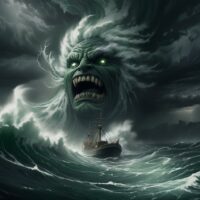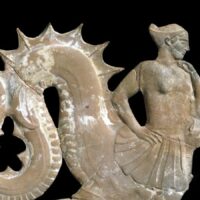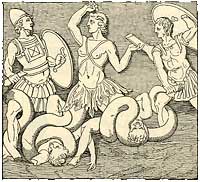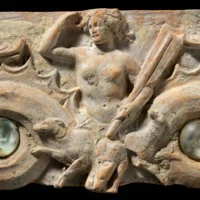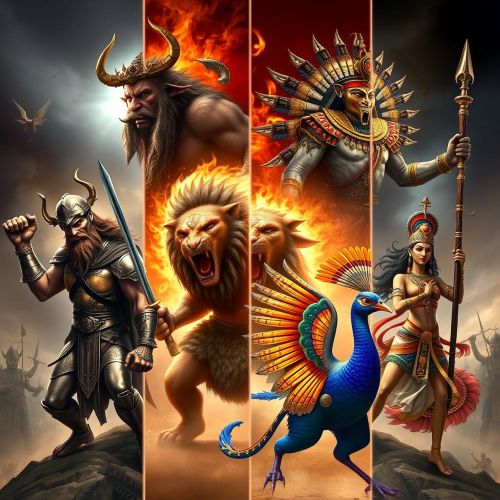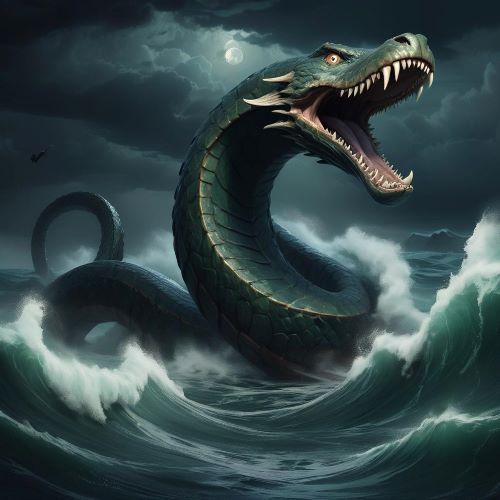Charybdis : The Whirlpool Monster
Listen
At a glance
| Description | |
|---|---|
| Origin | Greek Mythology |
| Classification | Animals |
| Family Members | Poseidon (Father), Gaia (Mother) |
| Region | Greece |
| Associated With | Whirlpools, Oceans, Seas |
Charybdis
Introduction
Charybdis looms large in Greek mythology, notorious for her relentless consumption of vast amounts of water, a feat performed thrice daily, resulting in treacherous whirlpools. The perilous strait of Messina serves as a backdrop to her legend, where sailors navigated with fear, wary of her deadly presence. With an insatiable appetite and formidable power, she traverses the ocean depths, conjuring whirlpools that engulf unsuspecting ships, perpetuating a legacy of fear and fascination. Charybdis, a name evoking danger and unpredictability, emerges as a monstrous entity in Greek lore, her solitary reign over the Strait of Messina marking her as a force to be reckoned with, a swirling abyss threatening any who venture too close.
Physical Traits
Charybdis, often portrayed as a colossal whirlpool rather than a typical sea creature, possessed a terrifying presence capable of engulfing entire ships. Descriptions depicted her as a gaping void in the ocean, capable of drawing in vast quantities of seawater and expelling it in whirlpools that posed imminent danger to nearby vessels. This portrayal diverged from conventional sea monster imagery, emphasizing Charybdis’s cyclical nature as she thrice daily consumed and regurgitated seawater, as described in Homer’s Odyssey.
In later interpretations, Charybdis took on a more monstrous form, sometimes depicted as a giant woman with an unquenchable appetite, perpetually confined to the depths where she voraciously consumed seawater. However, this anthropomorphic depiction was not as universally embraced as the portrayal of Charybdis as an all-consuming whirlpool.
Describing Charybdis proves akin to encapsulating a tempest’s essence, with ancient texts offering varied depictions. She appears as either a monstrous creature resembling a giant whirlpool or a gargantuan sea monster with multiple heads. Some liken her to a colossal mouth, ceaselessly gaping to consume all in her path. Her true form remains shrouded in mythic ambiguity, with tales suggesting she was once a beautiful nymph cursed by gods or an elemental force born from the sea’s chaos.
Family
Charybdis’ lineage, akin to the tumultuous currents she controls, intertwines divine and mortal origins. Across most traditions, she emerges as the offspring of Poseidon, god of the sea, and Gaia, the primordial earth goddess, imbuing her with formidable power and an innate connection to nature’s forces. Yet, her familial ties extend beyond divine realms. In certain myths, she shares siblinghood with Scylla, another formidable sea creature, weaving their destinies tightly within the fabric of mythology.
The lineage of Charybdis traces back to the primordial deities, Poseidon and Gaia, illustrating her divine heritage and the reverence instilled in ancient seafarers. However, the exact genesis of Charybdis remains veiled in mystery. Hesiod, an early Greek poet, ascribes her birth to Poseidon and Gaia, a lineage befitting her dominion over the ocean’s depths. Conversely, alternate narratives offer a divergent tale. Some myths depict Charybdis as a once-beautiful nymph, whose hubris incurred the wrath of Zeus, king of the gods. In punishment, she underwent a transformation into the monstrous whirlpool, a fate befitting her arrogance.
Other names
Across the annals of history, Charybdis has assumed myriad identities, each capturing a unique aspect of her enigmatic essence. In Greek literature, she predominantly goes by “Charybdis,” a name derived from the Greek word “kharybdis,” denoting the ominous whirlpool she embodies. Latin texts occasionally intertwine her name with that of her sister, dubbing her “Charybdis Scylla,” underscoring their joint role in maritime peril. Transcending cultural and linguistic barriers, her name reverberates as a harbinger of peril and annihilation, a testament to the enduring resonance of her myth.
While “Charybdis” stands as her primary epithet, variations surface throughout ancient texts. Homeric scholia, annotations on Homer’s epics, mention her as “Χάρυβδις” (Charybdis) and “Χάρυβδας” (Charybdas), minor alterations offering little insight into her mythic essence. However, beyond these linguistic nuances, alternate monikers emerge to encapsulate her fearsome persona. Referred to as the “Maelstrom” or the “Swallower of Ships,” these epithets vividly depict her as a relentless force of nature capable of engulfing vessels and altering the course of rivers, solidifying her legacy as a relentless force of destruction.
Powers and Abilities
Charybdis wielded formidable power through her ability to generate colossal whirlpools, capable of consuming entire ships along with their crews and cargo. The cyclical rhythm of these vortexes heightened their peril; sailors ensnared within faced a harrowing cycle of descent into the depths and expulsion, with the looming threat of being drawn back into the maelstrom during subsequent cycles. Some accounts embellished Charybdis’s abilities, attributing to her an insatiable hunger capable of devouring not just seawater but also land and livestock.
As a primordial force of the sea, Charybdis commanded unparalleled authority over the waters she inhabited. Her signature talent lay in conjuring lethal whirlpools, capable of ensnaring even the most imposing vessels and dragging them into oblivion. These vortexes were purportedly fueled by her ceaseless hunger, consuming everything unfortunate enough to cross her path. Legends further ascribed to her the manipulation of tides and currents, granting her control over the ocean’s very fabric to satisfy her desires. Despite her fearsome renown, Charybdis was often portrayed as a tragic figure, condemned by the gods to eternally crave the flesh of sailors, ensnared in a perpetual cycle of ruin and anguish.
Charybdis achieves iconic status in Homer’s Odyssey, where Odysseus, the resourceful hero navigating his tumultuous journey home from the Trojan War, faces the perilous Strait of Messina. Flanked by the six-headed monster Scylla on one side and Charybdis’s monstrous whirlpool on the other, Odysseus confronts an agonizing dilemma. Ultimately, he elects to steer closer to Scylla, sacrificing a portion of his crew to the multi-headed terror rather than risking the total annihilation threatened by Charybdis’s relentless vortex. This fateful encounter solidifies Charybdis’s mythic stature as an emblem of inevitable and lethal choices in the face of adversity.
Modern Day Influence
The enduring mythos of Charybdis retains its relevance in contemporary times, permeating language, literature, and art with its symbolic weight. The colloquial expression “between Scylla and Charybdis” has become entrenched in everyday speech, encapsulating the notion of being ensnared between two equally perilous alternatives, much like Odysseus confronted in his fateful voyage. This idiom vividly illustrates the predicament where any decision entails some measure of loss or risk.
Charybdis’s presence extends beyond the realms of myth and language, permeating various forms of fiction, from literature to video games. Her portrayal as a monstrous whirlpool serves as a potent metaphor for the omnipresent danger and awe-inspiring might of nature. Artists continue to depict her tumultuous waters and the visceral terror they evoke, ensuring her myth endures in the minds of modern audiences.
Moreover, Charybdis’s legacy transcends the confines of artistic representation, influencing scientific terminology as well. Oceanographers utilize the term “charybdis” to denote particularly hazardous whirlpools, a testament to the enduring impact of her myth on our understanding of marine phenomena.
Related Images
Frequently Asked Questions
What is lorem Ipsum?
I am text block. Click edit button to change this text. Lorem ipsum dolor sit amet, consectetur adipiscing elit. Ut elit tellus, luctus nec ullamcorper mattis, pulvinar dapibus leo.
What is lorem Ipsum?
I am text block. Click edit button to change this text. Lorem ipsum dolor sit amet, consectetur adipiscing elit. Ut elit tellus, luctus nec ullamcorper mattis, pulvinar dapibus leo.
What is lorem Ipsum?
I am text block. Click edit button to change this text. Lorem ipsum dolor sit amet, consectetur adipiscing elit. Ut elit tellus, luctus nec ullamcorper mattis, pulvinar dapibus leo.
What is lorem Ipsum?
I am text block. Click edit button to change this text. Lorem ipsum dolor sit amet, consectetur adipiscing elit. Ut elit tellus, luctus nec ullamcorper mattis, pulvinar dapibus leo.
What is lorem Ipsum?
I am text block. Click edit button to change this text. Lorem ipsum dolor sit amet, consectetur adipiscing elit. Ut elit tellus, luctus nec ullamcorper mattis, pulvinar dapibus leo.

